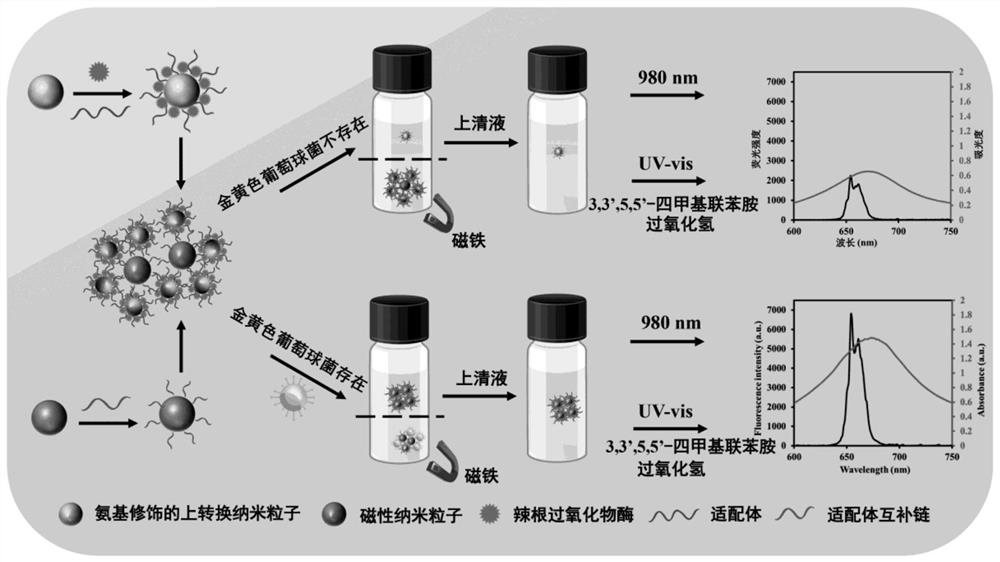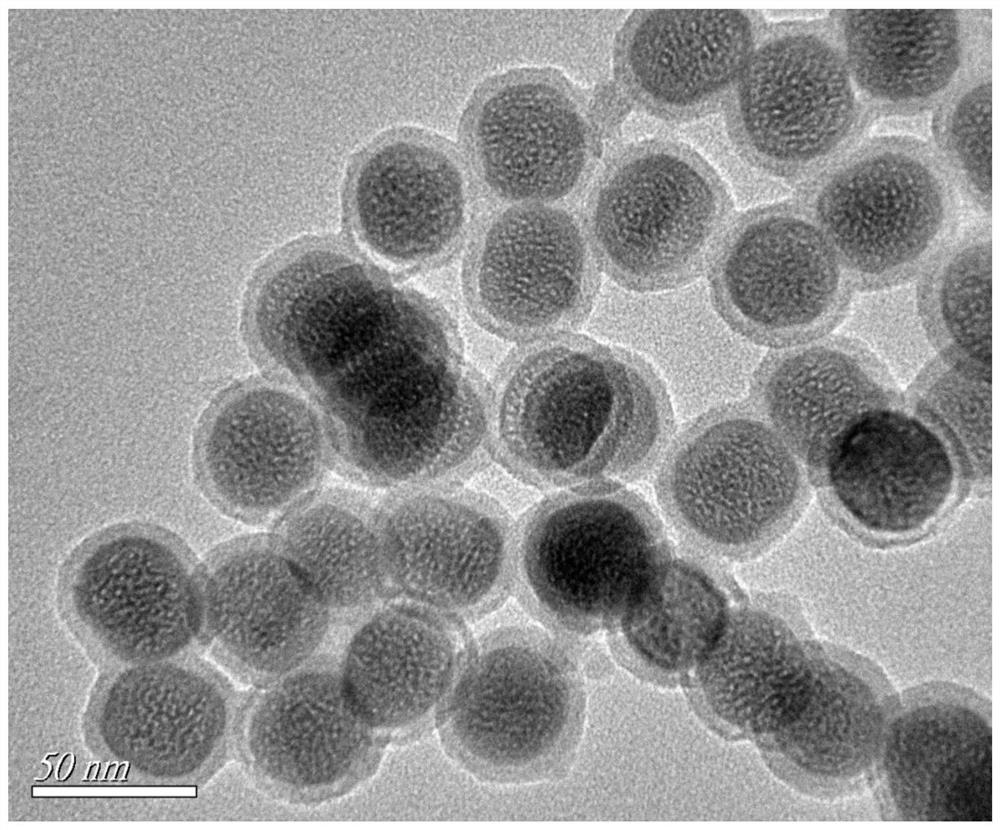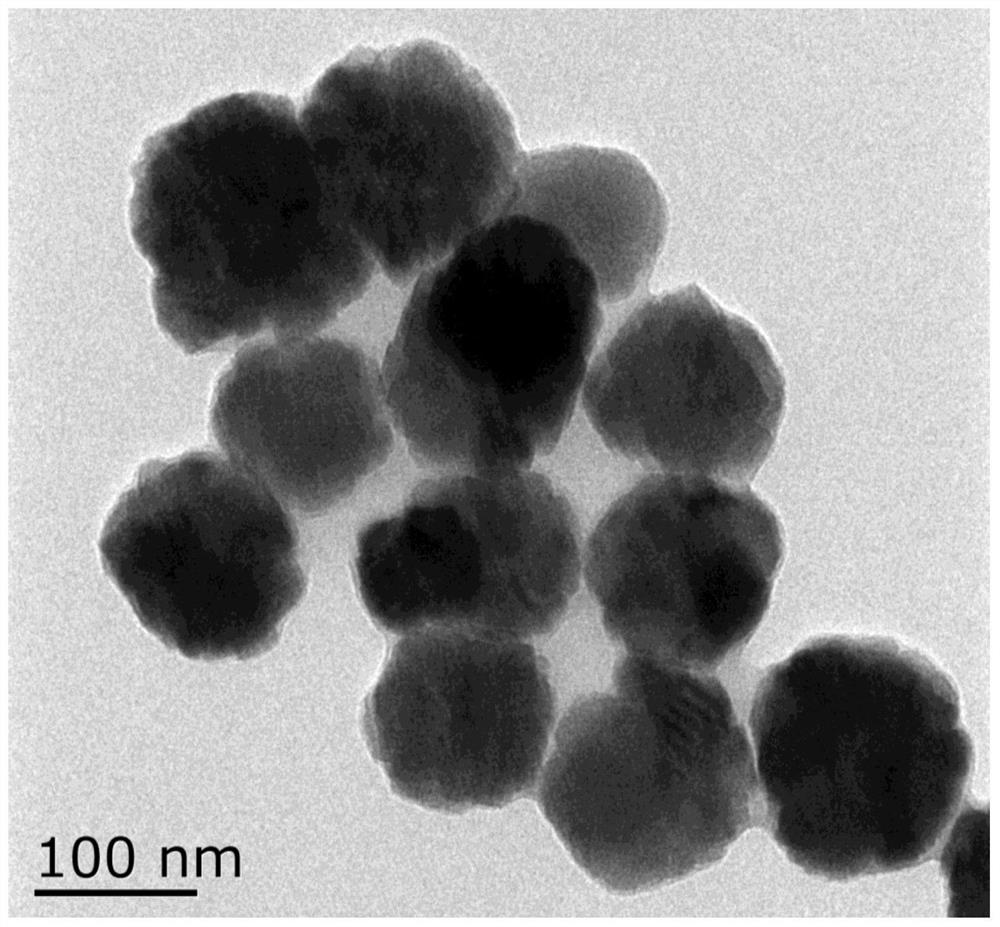A dual-signal detection method for Staphylococcus aureus in food
A staphylococcus and detection method technology, applied in the field of microbial detection, can solve problems such as unfavorable detection promotion, expensive laboratory facilities, complex pretreatment procedures, etc., to ensure food safety, wide concentration detection range, and eliminate background fluorescence and other ions. the effect of interference
- Summary
- Abstract
- Description
- Claims
- Application Information
AI Technical Summary
Problems solved by technology
Method used
Image
Examples
Embodiment 1
[0043] Embodiment 1 The dual-signal detection method of Staphylococcus aureus in pork, the concrete steps are:
[0044]Step 1, preparation of water-soluble up-conversion nanomaterials: accurately weigh 0.1183g yttrium chloride hexahydrate, 0.0388g ytterbium chloride hexahydrate and 0.0038g erbium chloride hexahydrate, dissolve them with 10mL of methanol ultrasonically for 10min, and transfer them into a 250mL three-necked round-bottomed flask containing 6mL of oleic acid and 10mL of 1-octadecene (oleic acid: 1-octadecene=3:5); under argon protection, magnetic stirring and heating to 160°C, After maintaining for 40min to form a transparent solution, it was naturally cooled to room temperature; then, a 10mL methanol mixture dissolved with 50mg sodium hydroxide (1.25mmol) and 70mg ammonium fluoride (2mmol) was added dropwise to the above flask to form a white suspension. The turbid liquid was then heated to 45 °C and kept for half an hour under closed conditions; then, the device...
Embodiment 2
[0053] Embodiment 2 The double signal detection method of Staphylococcus aureus in beef, concrete steps are:
[0054] Step 1, preparation of water-soluble up-conversion nanomaterials: accurately weigh 0.1183g yttrium chloride hexahydrate, 0.0388g ytterbium chloride hexahydrate and 0.0038g erbium chloride hexahydrate, dissolve them with 10mL of methanol ultrasonically for 10min, and transfer them into a 250mL three-necked round-bottomed flask containing 6mL of oleic acid and 14mL of 1-octadecene (oleic acid: 1-octadecene=3:7); under argon protection, magnetic stirring and heating to 160°C, After maintaining for 40min to form a transparent solution, it was naturally cooled to room temperature; then, 10 mL of methanol mixture dissolved with 50 mg of sodium hydroxide (1.25 mmol) and 74.1 mg of ammonium fluoride (2 mmol) was added dropwise to the above flask to form a white The suspension was then heated to 45 °C for half an hour under closed conditions; then, the device was turned...
Embodiment 3
[0063] Embodiment 3 The double-signal detection method of Staphylococcus aureus in milk, concrete steps are:
[0064] Step 1, preparation of water-soluble up-conversion nanomaterials: accurately weigh 0.1183g yttrium chloride hexahydrate, 0.0388g ytterbium chloride hexahydrate and 0.0038g erbium chloride hexahydrate, dissolve them with 10mL of methanol ultrasonically for 10min, and transfer them to a 250mL three-necked round-bottomed flask containing 6mL of oleic acid and 20mL of 1-octadecene (oleic acid: 1-octadecene=3:10); under argon protection, magnetic stirring and heating to 160°C, After maintaining for 40min to form a transparent solution, it was naturally cooled to room temperature; then, 10mL methanol mixture dissolved with 50mg sodium hydroxide (1.25mmol) and 75mg ammonium fluoride (2mmol) was added dropwise to the above flask to form a white suspension. The turbid liquid was then heated to 45 °C and kept for half an hour under closed conditions; then, the device was...
PUM
| Property | Measurement | Unit |
|---|---|---|
| concentration | aaaaa | aaaaa |
Abstract
Description
Claims
Application Information
 Login to View More
Login to View More - R&D
- Intellectual Property
- Life Sciences
- Materials
- Tech Scout
- Unparalleled Data Quality
- Higher Quality Content
- 60% Fewer Hallucinations
Browse by: Latest US Patents, China's latest patents, Technical Efficacy Thesaurus, Application Domain, Technology Topic, Popular Technical Reports.
© 2025 PatSnap. All rights reserved.Legal|Privacy policy|Modern Slavery Act Transparency Statement|Sitemap|About US| Contact US: help@patsnap.com



